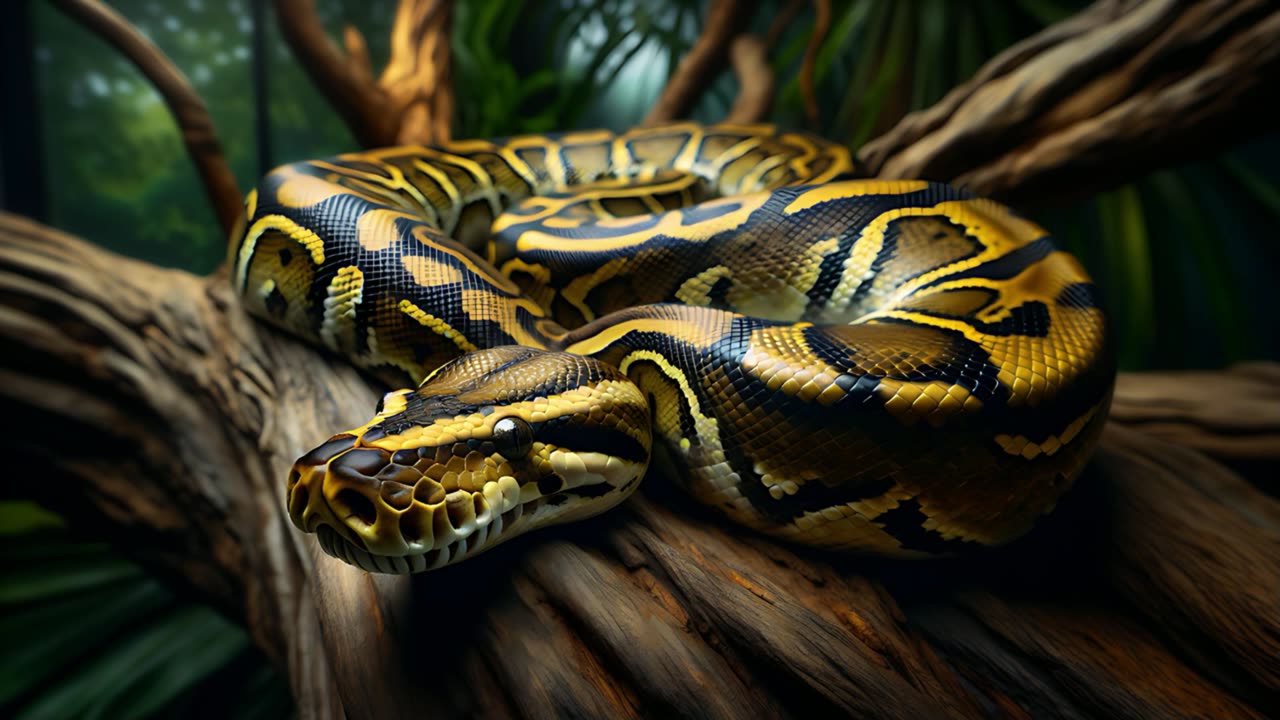Premium Only Content

Pythons - Fascinating giants of the snake world - mini Doku.
Pythons are among the best-known and largest snakes in the world. These non-venomous constrictors belong to the Pythonidae family and are native to tropical and subtropical regions of Africa, Asia and Australia. With their impressive size, their sophisticated hunting behaviour and their role in ecosystems, they have always held a special fascination for humans.
There are over 40 species of python, which vary greatly in size and habitat. While the reticulated python is considered the longest snake in the world at up to 8 metres in length, the king python from West Africa remains comparatively small at around 1.5 metres. They are characterised by their forked tongue for detecting prey, heat-sensing pits on their lips (in some species) for sensing body heat and their muscular body structure.
Pythons are nocturnal ambush hunters. They camouflage themselves perfectly in their surroundings and wait motionless for prey such as rodents, birds or even medium-sized mammals. With a lightning-fast grab, they fix the victim with their backward-curved teeth, then wrap their body around it and suffocate it by contracting their muscles. Depending on the size of the prey, the digestion process can take days or weeks, during which the snake remains inactive.
In contrast to many other snakes, pythons lay eggs (oviparous) and exhibit unusual brood care behaviour: Females coil around their clutch (up to 100 eggs) and raise the temperature by muscle tremors to protect the embryos. Young animals are independent from the moment they hatch. Their ability to regenerate is also interesting: lost scales or damaged areas of skin can grow back completely.
As top predators, pythons regulate the populations of their prey and thus contribute to the ecological balance. However, in some regions (e.g. Florida), introduced species such as the Burmese python have become a threat to native species, highlighting the complex role of invasive species.
While pythons are revered in many cultures as a symbol of power or fertility, they are now also popular as exotic animals in the terrarium hobby. However, keeping them is demanding - large species in particular require a lot of space and expertise. Species conservation projects are campaigning against poaching and habitat loss, as some species are endangered by trade and the destruction of rainforests.
Pythons are often confused with boas. A key difference lies in reproduction: boas give birth to live young (viviparous), while pythons lay eggs. In addition, boas also occur naturally in America, whereas pythons do not. Very interesting snakes Have you ever seen a python? I would really appreciate a like and a subscription.
Shirts and more
Designs Redbubble
https://www.redbubble.com/people/ReneMM/shop?asc=u
Spreadshirt.at
https://www.spreadshirt.at/shop/user/renemm/?srEdit=pa#?affiliateId=1257693
Spreadshirt.com
https://www.spreadshirt.com/shop/user/renemm/?srEdit=pa#?affiliateId=11625
Shirtee.at
https://www.shirtee.com/de/catalogsearch/result/index/designer_id/112048/all_stores/
1/
Pictures
https://fineartamerica.com/profiles/rene-mitterlehner
-
 1:51:06
1:51:06
Redacted News
3 hours agoTrump Rolling Out $2,000 STIMULUS Checks in 2025 as the U.S. Economy Flashes RED | Redacted News
141K167 -
 LIVE
LIVE
Dr Disrespect
8 hours ago🔴LIVE - DR DISRESPECT - ARC RAIDERS - THE VENATOR SLAYER
1,331 watching -
 13:26
13:26
Cash Jordan
2 hours agoChicago "RIOTERS" Get CRUSHED... Mayor FREAKS as 'Imported Mob' HAMMERED BY MARINES
3.93K1 -
 2:01:03
2:01:03
vivafrei
6 hours agoOstrich Farm Update w/ Chris Dacey; Jan. 6 Pipe Bomber IDENTIFIED? w/Kyle Serraphin & MORE!
79.5K59 -
 1:01:11
1:01:11
The Amber May Show
5 hours ago $0.24 earnedShutdowns, Shakeups, and 50-Year Mortgages | Sam Anthony
3.68K2 -
 5:47:52
5:47:52
StoneMountain64
6 hours agoBattlefield REDSEC $100k tourney tomorrow
11.1K1 -
 LIVE
LIVE
GritsGG
4 hours ago#1 Most Warzone Wins 3957+!
43 watching -
 2:00:02
2:00:02
The Quartering
5 hours agoDemocrat Civil War After Collapse, Viral Wedding Ring Insanity, New Trump Pardons & Huge Trans Ban
165K75 -
 LIVE
LIVE
ZWOGs
4 hours ago🔴LIVE IN 1440p! - ARC RAIDERS! Grinding XP and Upgrades! - Come Hang Out!
31 watching -
 LIVE
LIVE
Meisters of Madness
2 hours agoNinja Gaiden 4 - Quest for The Master Difficulty
13 watching